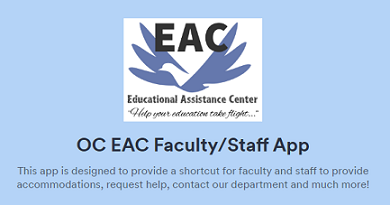Useful Reference Material
The EAC has compiled information and resources for Faculty to help make working with students with disabilities a smooth and friendly experience. Check out our Faculty Handbook for an in-depth guide to best practices!
Curious about Section 504 of the Rehabilitation Act? Check out our 504 Fact Sheet and do what you can to help our campus be compliant.
If you have any questions, please contact us for more information. We're happy to help!
We Have an App!
Access all your EAC services and requests from our Faculty/Staff App! From here, you can:
- Submit a Test Proctoring Request Form for a student with testing accommodations
- This form will be sent directly to the Test Proctoring Center in the Library/LRC
- You will be able to provide special instructions to the proctor via this form
- You will be able to upload your exam via this form if you wish
- Request an interpreter for an event
- Ask questions about class accessibility
- Schedule a class presentation about our services
- Contact our individual staff members
...and more! It's a one-stop shop for all your EAC needs. Bookmark our app on your browser or add it to your smartphone's homepage.
What are Accommodations?
Colleges are required to provide reasonable accommodations (academic adjustments, auxiliary aids, services, and educational assistance courses) so that students with verified disabilities can fulfill academic requirements.
These accommodations may include, but are not limited to:
- Changes in teaching methods or materials
- Increased time allowances
- Alternate assignments
- Substitution of equivalent courses. Link to Academic Senate Policy
Effective accommodations relate directly to the student’s educational limitation. They are designed to:
- Overcome disadvantages imposed by a disability.
- Provide equal opportunity for achievement.
- Address individual needs.
- Be provided as a legal right, not as a privilege.
Effective accommodations preserve academic integrity. They must not:
- Provide a competitive advantage.
- Lower the academic standard by “watering down” content.
- Lower the academic standard by grading the student more leniently.
- Continue if ineffective or no longer required.
Academic accommodations are not required if they would alter the fundamental nature of a course or a program. However, the burden of proof is on the college to demonstrate that the student’s accommodations will alter the fundamental nature of a course or a program. A central consideration is that the college administration and the faculty/staff member have made good faith efforts to provide appropriate, reasonable, and equal access to the college’s educational programs, services, and activities without altering their fundamental nature.
Test Proctoring Center
You may provide an EAC student their testing accommodations in your own classroom environment as long as you are able to provide them with extra time or any of their other accommodations. Alternatively, you may opt to allow them the opportunity to take their exam in the Test Proctoring Center on campus.
- Location: Second floor of the Library/LRC
- Hours:
- Monday/Tuesday: closed
- Wednesday/Thursday: 12 pm - 7 pm
- Friday: 9 am - 12:30 pm
- Saturday/Sunday: closed
- Fall Closures: 9/1, 10/8, 11/11, 11/27, 11/28, 12/12-1/11
- Appointments: Students are allowed to show up within the window of time you provide
- Types of Exams: You can request proctoring for a paper/pencil/Scantron test, or an online exam in Canvas
- Requests (Faculty only): Complete the Test Proctoring Request Form and upload the exam within the form (if you wish)
- Supervisor: Gilbert Downs
- Proctor: Vanessa Arroyo
Teaching Guidelines
If you are teaching a class, please consider it best to be proactive rather than reactive. Utilizing these guidelines and tips prior to a request for services will help take the stress off what could be a last-minute request.
What You Should Know...
Below you will find a quick reference to important information you should know about laws, policies, and rules that govern academia. Again, if you have any questions or would like more information, please contact the EAC for assistance.

